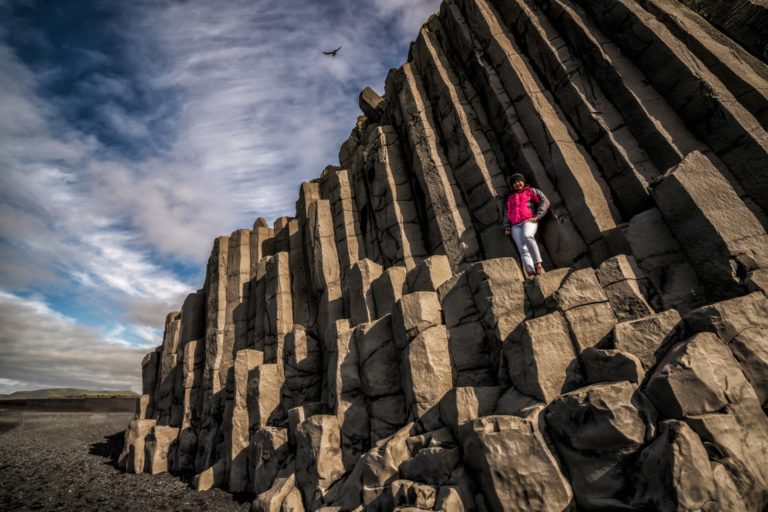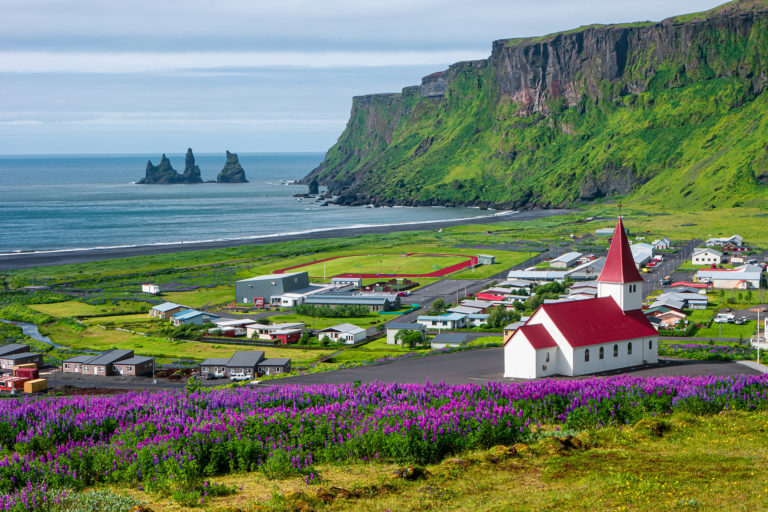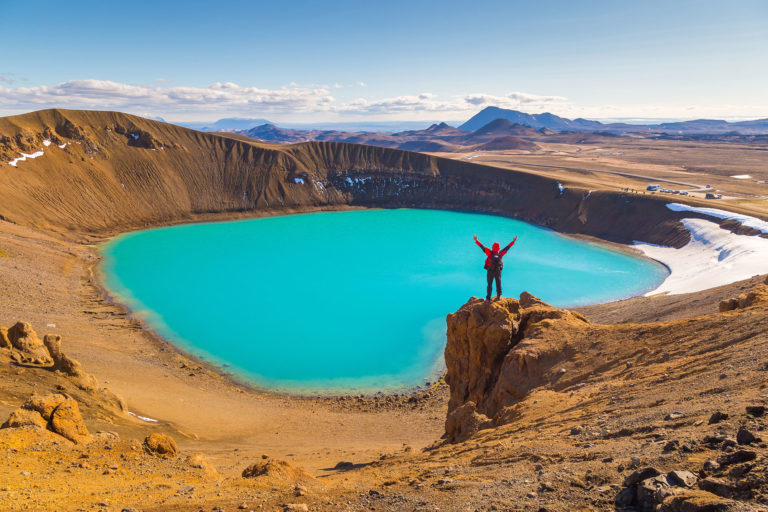The Highlands of Iceland is a tundra wilderness covering 40,000 km2 (15,444 sq. mi.) of the uninhabited interior of the country. It’s one of Europe’s greatest unpopulated areas and will soon be the largest national park on the continent. Even though it’s the most remote region in Iceland and large parts of it are only accessible by helicopters, many of the country’s most impressive natural attractions are hidden here.
In this article, you’ll learn about the history and geology of this vast region along with additional practical information that will help you plan your trip. In another article, you’ll find a detailed list of the must-see attractions and must-visit places in the Icelandic Highlands.
How to Get Around in the Highlands of Iceland
The Highlands area is situated 400–500 m (1300–1600 ft.) above sea level. It’s mostly an uninhabitable volcanic desert. Because of this, there’s no permanent settlement here and there never has been. For centuries, the locals didn’t even attempt to cross the interior as it was believed to be a life-threatening journey due to the harsh weather and hostile environment there.
Today, it’s possible to travel to the Highlands, but unlike the other regions of Iceland, traveling here can be especially challenging for those who want to drive themselves. There are safe, guided tours available to the most popular sites, though.

Infrastructure
There’s no infrastructure in the Icelandic Highlands. There are no settlements, no gas stations, and no supermarkets in the entire region. However, there are a few campsites, some of which are quite busy and offer great facilities in addition to the camping space, including bunk beds in the mountain huts, hot showers, electricity, or even restaurants.
These can be found in Thorsmork, Landmannalaugar, Kerlingarfjoll, and Askja. Most of these tourist centers only operate during the summer season, but there are a few that remain open during the winter months, offering limited services.
If you’d like to stay in any of these mountain huts, booking ahead is a must. Tent campers don’t need to book in advance. Please note that most of the Icelandic Highlands are part of protected nature reserve areas, so wild camping isn’t allowed in many places. In addition, camping in the Highlands will require really good gear and previous camping experience. This is due to the special weather and terrain characteristics that we’ll discuss later in this article.

Road Conditions
The Icelandic F-Roads are rough mountain tracks that are closed for most of the year. These roads aren’t maintained in the winter, which lasts from October until June in this area. These are the only roads that enter the breathtaking Highlands. They vary in quality and can often disappear into rivers. If you want to drive on these roads, you’ll need a 4×4 vehicle. Any other type of car won’t be suitable and will only result in large fees for damage or rescue services.
Driving here is quite the challenge, even in the best weather conditions. A normal, small car can’t be driven in this area. When you rent a car, the rental company will normally specify whether you can drive that car you’ve chosen in the Highlands or not. Even if the car is big enough and is allowed on the F-Roads (also known as mountain roads), most companies won’t provide you with the insurance that would cover you in the event of a river crossing.

If you’d like to drive in the Highlands and cross unbridged rivers, you’ll simply have to do so at your own risk. If you’re planning to rent a car and explore the area on your own, make sure to look at the policies of your chosen rental company in advance.
Roads open around mid-June and remain open until mid-September. The exact dates can vary year by year, depending on the actual weather conditions. On this page, you can learn more about the Highlands roads and their opening and closing dates.
When the roads are inaccessible, you can still get to the Highlands via guided tours. Local companies have specialized mountain trucks that we call Superjeeps, even though not all of these cars are actually Jeeps. They’ve been specially designed and modified for this terrain, so they can easily cross icy rivers and drive in snow that is meters high.

Public Transport
There’s no public transport service in the Highlands because there are no settlements here. The best alternatives to public transport in the summer are the buses owned by private companies. These run once or twice a day from mid-June until mid-September, but the weather and road conditions can affect the season’s opening and closure.

Guided Tours
Since the Highlands region isn’t easily accessible, there are plenty of guided tours offered that can take you there. Thanks to the Superjeeps, sightseeing day tours, multi-day tours, easy day hikes, adventurous multi-day treks, winter tours, snowmobiling, and snowshoeing are all offered, just to mention a few options out of the many.
The safest and most fun way to explore this area is to join a guided tour. Guides that drive there on a daily basis are specially trained to operate the Superjeeps, which they need a special driving license for. The hiking guides are trained wilderness first-responders. Adventures are great, but safety should always come first!

Self-Drive Tours
There are places in the Highlands that are more easily accessible than others. Getting to Landmannalaugar or driving along the Kjölur route, for example, won’t require river crossings. You’ll still need a larger car and the roads are quite bumpy, though.
Many visitors also choose to cross the rivers. Most of the time, they do so safely and successfully. There are very few river-related accidents in Iceland, but cars will get trapped in a river a few times every year. Sadly, fatalities also happen every few years. These are usually due to underestimating dangers, such as sudden changes in the water level.
Experienced drivers who would like to drive to Thorsmork, Kerlingarfjoll, or other parts of the Highlands that require river crossings can prepare for the challenges involved by researching this topic, discussing it with a safety agent or the rental provider, and by watching plenty of videos just to see what conditions they can expect.

Check the warnings and road conditions daily before hitting the road. Ideally, you should wait for another car before crossing the river so you can help each other if someone gets in trouble. Get more tips in this article about driving across rivers in Iceland.
Keep in mind that Iceland is just as delicate as it is captivating. The natural beauty of the Highlands is a gift from nature, so even the smallest amount of damage can have unforeseen consequences, including erosion and irreversible wounds to the landscape.
For this reason, any visitors to the Highlands must follow strict travel etiquette rules. Driving off-road or off the officially designated paths is completely forbidden and will result in hefty fines. The moss that covers the ground is very fragile, so you should neither walk on it or camp on it. Fishing is highly regulated in Iceland as well.

The Weather in the Highlands of Iceland
The climate in this region is subarctic tundra, so the weather is significantly different from the coastal areas. The Highlands is the coldest and driest region of the country. However, the areas directly around the largest glaciers get the most precipitation of the whole country, five times more per year than the United Kingdom!
The temperatures in the Highlands tend to be much lower than in the rest of Iceland. In winter, you can expect the thermometer to stay below -10°C (14°F). In the summer, the temperature rarely rises above 10–15°C (50–59°F). The soil in the tundra is usually frozen for anywhere from eight to nine months per year. You can also expect extreme winds.
The frequency of storms is also the highest in this region, especially between September and March. By Icelandic standards, a storm happens when the wind speed surpasses 65 km/h (18 m/s or 40 mph). In populated areas, you can expect from 10 to 20 stormy days per year. In the Highlands, this number can jump to more than 50 days per year.

The strongest wind ever measured in the country was in East Iceland in 2015, measuring a roaring 262 km/h (72.7 m/s or 162.7 mph). This record was matched in the Icelandic Highlands in 2018. While these kinds of extremes aren’t very common, it’s good to be mentally and physically prepared for wind, when you’re going hiking or camping in particular.
The best forecast sites for the Icelandic Highlands are the Norwegian Meteorological Institute and belgingur.is.
Geology
The altitude in the Highlands is over 500 m (1640 ft.) above sea level. There are a large number of mountains here that reach up to anywhere from 1000–2000 m (3281–6562 ft.) and these tall mountains are generally covered by ice caps.
In fact, the tallest mountain in Iceland can be found in the Highlands. Hvannadalshnúkur reaches an astonishing height of 2109 m (6919 ft.) and is topped by the largest glacier in Europe: Vatnajökull. You can visit the top of this impressive mountain on certain helicopter tours. Another slightly shorter but also notable mountain is Bárðarbunga. This peak reaches 2000 m (6561.7 ft.) and can be found in the northwest corner of Vatnajökull.
Vatnajökull itself is the largest of the three glaciers found in this region. It’s accompanied by Hofsjökull in the center of the country and Langjökull, which lies the furthest west. Aside from the mountains and glaciers, most of the Highlands is made up of barren volcanic deserts and vast rocky plateaus.
Any precipitation here, whether rain or snow, filters into the ground so quickly that the plants can’t access it in time to grow. This lack of plants leaves the Highlands painted grey, black, and brown, the colors of the volcanic ashes, lava, and earth. The only green areas are located near rivers, such as Thorsmork in the south and Herðubreiðarlindir, near Askja.

History
In old times, the locals considered the Highlands area an inhospitable place. Since most of the country’s volcanoes and glaciers are located here, this region was the source of everything that threatened the safety of the locals: eruptions, glacial floods, hostile weather conditions, and uninhabitable land.
Even the horse-riding Vikings, in the olden times, knew that this land was highly hostile and could kill them at any time – and it sometimes did. After the centralized parliament in Althingi was established, the chieftains would have to take their annual journey to Thingvellir to participate in the governing body. Most would take longer routes along the coast to avoid the barren Highlands.
Many people believed that this unfriendly mountainous area was filled with trolls, elves, and dangerous outlaws. This makes sense when you consider that criminals in Iceland were often punished by being thrown out of society and forced to live in the wilderness.
For these reasons, added to the terrible road conditions, the Icelandic Highlands remained relatively unexplored for centuries. The first road to cross the Highlands was constructed around the year 1900. By connecting North Iceland with South Iceland, this road made it possible for both adventurers and scientists to finally explore the inland area more profoundly.

Things to See in the Highlands of Iceland
The Icelandic Highlands can be divided into four regions: the North, South, East, and Central Highlands. In this separate article, you’ll find detailed descriptions of all the must-visit places in the Icelandic Highlands.
Things to Do in the Highlands of Iceland
Hiking
The Highlands don’t offer the best terrain for road tripping. Once you get to your destination by car, leave it behind and continue your journey on foot. This landscape is the ultimate hiker’s paradise. Even if it’s just a volcanic desert, the moonlike terrain, steamy green oases, black deserts, and troll-like rocks that accompany you along the journey create an atmosphere that you won’t find anywhere else in the world.

The Laugavegur Trail
Found in the southwestern Highlands, Laugavegur is the most famous hiking trail in the country. The name of this trail translates as the “Hot Spring Route” in English, which is quite appropriate when you consider the number of steaming hot springs it leads by.
It will also take you through black lava fields, colorful rhyolite mountains, moss-painted oases, thrilling landscapes, and black deserts. This 55-km (34-mi) trail starts in the steamy rhyolite mountains of Landmannalaugar and ends in the green, forested valley of Thorsmork. There are mountain huts along the way that you can stay in. Most people complete the trek in four days.

The Fimmvorduhals Trail
After Laugavegur, Fimmvörduháls comes in a close second in terms of popularity. This trail begins in Skógar, at the top of the gorgeous Skógafoss Waterfall. It will carry you 25 km (15.5 mi.) along a river and up into the mountains past an uncountable number of waterfalls.
The trail then leads up to the brand new volcanic craters created by the Eyjafjallajökull eruption, crosses the pass between three glaciers, and descends sharply into the incredibly scenic Thórsmörk valley. Many people choose to connect the Laugavegur and Fimmvorduhals trails into an adventurous 6-day trek.

The Kjölur Trek
The Kjölur Trek leads 44 km (27.3 mi.) between two glaciers in the very heart of the Highlands, going from Hvítárnes to Hveravellir. In the Hveravellir area, there are hot springs that invite the tired hikers to bathe and relax in their warm water after their long treks.
The Askja Trek
The most famous trekking route in the eastern Highlands leads to Askja caldera, an impressive crater lake. This trek across the largest continuous lava field in the country will require five days to finish as it covers 97 km (60.2 mi.).
Along the way, you’ll see impressive landscapes, rocky deserts, and gorgeous volcano-mountains. There are a number of huts along the way that offer hikers limited facilities. If you’re planning on sleeping in these huts, you should book your spot months in advance, just to be sure.

Horseback Riding
Horseback riding in the Highlands is probably the most authentic way to explore the area. Vikings in the old times traveled in this way. The Highlands are untouched, quiet, and there are some amazing trails made especially for riders. This activity is only recommended for experienced and adventurous riders as it includes long stretches of riding and sleeping in tents in the wilderness.
Geothermal Bathing
Some of the best hot springs in the country are located in the Highlands. There’s nothing better than bathing in natural hot springs in the middle of nowhere! Since you’ll be in the middle of nowhere, keep in mind that these hot springs won’t always have changing facilities.
Take a dry bag with you to protect your clothes while you’re enjoying your soak in the warm water. Also, make sure that you take everything with you when you leave. Don’t leave any swimsuits, underwear, or waste behind.

Hveravellir Hot Spring
In the Central Highlands, right between Langjökull and Hofsjökull Glaciers, is a stunning protected nature reserve full of steaming fumaroles and sky-blue boiling water. Measuring approximately 6 m by 3 m (19.7 by 9.8 ft.), the Hveravellir thermal pool sits in a warm river.
This ensures that warm water is constantly entering the pool and that the current keeps it naturally clean. You’ll find a service center next to the hot spring with a large campsite, changing facilities, huts, and a quaint restaurant. Using any of the facilities will cost a small fee of around ISK 500 per person, but this single fee will give you access to parking, toilets, showers, and the geothermal pool.
Landmannalaugar Hot Spring
The hot spring in Landmannalaugar is quite popular and it often gets crowded at the peak of the summer. The bathing area is quite large and the water doesn’t get too deep. This natural pool is filled by hot water that filters through lava, remaining at a pleasant 36–40°C (96–104°F) all year round. Locals love this place and so do tourists.
There is a lodge a few minutes’ walk from the pool that has showers and changing facilities. The pool is free and open to the public, but you’ll have to pay a small fee if you want to use the facilities, so bring some coins with you.

The Kerlingarfjöll Hot Spring
There is a hot spring in Kerlingarfjöll, in the heart of the Central Highlands, which is suitable for bathing. You’ll find this hot spring in a small valley near the hotel. The 1.5-km (0.9-mi) path follows a small river and is marked.
This hot spring was initially just a test drill to see if there was enough hot groundwater to heat the houses of the local people. Afterward, the geothermal pool was made out of stones, which is big enough for 10 to 15 people to fit at a time. The iron-rich water in the pool remains around 34–37°C (93–38°F) and is a bit hotter in the center.
Snowmobiling and Snowshoeing
The Highlands have the longest winter in the country and there is snow here for about eight months per year. Locals love snowmobiling and do so in this region – when the weather allows, of course. Although you can’t do this activity without a guide, we highly recommend booking a tour if you like these kinds of winter adventures.
Tours to Kerlingarfjoll are available all year round. They offer guided snowmobiling and snowshoeing tours from the hut whenever there’s enough snow for it. After the ride, you can even take a bath in the hot spring, which is the perfect way to end the day. Even in the busiest years, the winter season is very slow here. Only a handful of visitors are ever visiting here at any time, so it’s highly recommended for those who would like to avoid the crowds!





